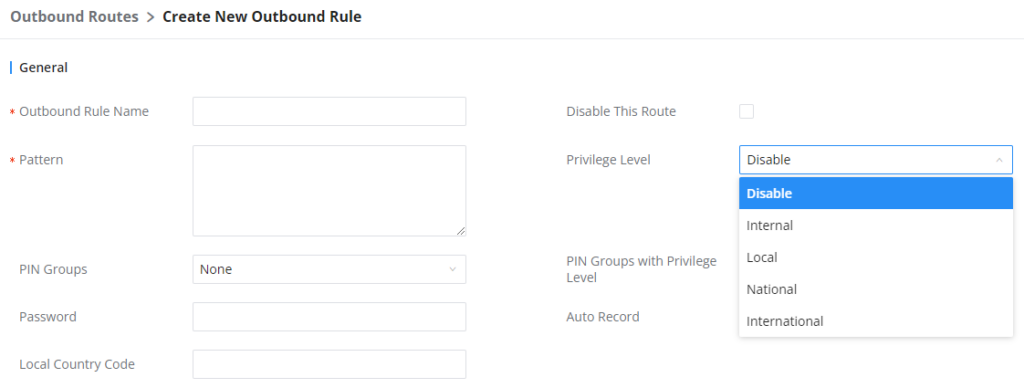This article introduces the concepts of permission and privilege levels along with related settings on the UCM6XXX series IP PBX. The permission and privilege settings are used to control the calls on extensions, IVRs, inbound and outbound routes so that the UCM6XXX can securely handle the calls as desired.
The following levels are the four levels of permission/privilege settings on the UCM6XXX:
- Internal: The lowest level. This is the default level.
- Local.
- National.
- International: The highest level.
Those options apply to extension setting (Permission), IVR setting (Permission), inbound route setting (Privilege Level), and outbound route setting (Privilege Level).
Please note that these levels are for classification purposes only and don’t reflect any permission on real call service type (as local, long-distance calls …) which you need to check with your service provider.
Configuring Extension Permission
On the UCM6XXX web GUI, create an extension under Extension/Trunk🡪Extensions. Users shall see the “Call Privileges” option with four levels in the drop-down list.
Call Privileges option restricts whether this extension could be used to make desired outgoing calls. The extension needs to be assigned with higher level (or equal level) permission compared to the outbound rule’s privilege in order to make outbound calls with that rule.
Configuring Outbound Route Privilege
When creating a new outbound rule under Extension/Trunk🡪Outbound Routes, users shall see the “Privilege Level” option with four levels in the drop-down list.
When making an outbound call via this route from a UCM6XXX extension, the UCM6XXX will compare the extension’s permission level with the outbound route’s privilege level. If the extension’s permission level is higher than (or equal to) the outbound route’s privilege level, the call will be allowed to go through.
Please see more descriptions below:
- Disable: It can only be used by matched Source Caller ID.
- Internal: The lowest level required. All users can use this rule.
- Local: Users with Local, National, or International level are allowed to use this rule.
- National: Users with National or International level are allowed to use this rule.
- International: The highest level required. Only users with international level can use this rule.
Configuring Inbound Route Privilege
When creating a new inbound rule under Extension/Trunk🡪Inbound Routes, users shall see the “Privilege Level” option with four levels in the drop-down list
Privilege Level option applies to the inbound rule only when “Default Destination” is set to “By DID” and the “Dial Trunk” option is enabled. (IVR is handled in a different way, the other options in the “Default Destination” can be considered as internal extensions on the UCM6XXX).
When there is an inbound call from the trunk to the UCM6XXX via this inbound route, the UCM6XXX will compare the inbound route’s privilege level with the matching outbound route’s privilege level (i.e. the DID pattern in this inbound route matches one of the outbound routes). If the inbound route’s privilege level is higher than (or equal to) the matching outbound route’s privilege level, the call will be allowed to go through.
Configuring IVR Permission
When creating an IVR under Call Features🡪IVR, users shall see “Dial Trunk” and “Permission” options. By default, the “Dial Trunk” option is disabled. Also, the “Permission” level is set to “Internal” (lowest level) and is not configurable.
If “Dial Trunk” is enabled, users can specify the IVR permission level. Therefore, the calls coming into IVR can dial outbound via the trunk. In this case, the UCM6XXX will compare the IVR’s permission level with the outbound route’s privilege level. If the IVR’s permission level is higher than (or equal to) the outbound route’s privilege level, the call will be allowed to go through.



